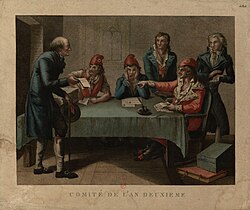Revolutionary sections of Paris

Therevolutionary sections of Pariswere subdivisions of Paris during theFrench Revolution.They first arose in 1790 and were suppressed in 1795.
History[edit]
At the time of the Revolution, Paris measured 3440 hectares, compared to the 7800 hectares of today. It was bounded to the west by theplace de l'Étoile,to the east by thecimetière du Père-Lachaise,to the north byplace de Clichy,and to the south by thecimetière du Montparnasse.Under theAncien Régime,the city had been divided into 21 'quartiers'.
In 1789, with a view to elections to theEstates-General,it was instead divided provisionally into 60 districts. By a decree of 21 May 1790, sanctioned by KingLouis XVIon 27 June, theNational Constituent Assemblycreated 48 'sections' ('section' then meaning a territorial and administrative division) to replace the 60 districts. Each section was made up of a civil committee, a revolutionary committee and an armed force.
After theThermidorian Reactionon 27 July 1794, the sections still played an important role in suppressing the popular uprisings. In 1795, however, they were suppressed by theFrench Directory,which renamed the areas covered by sections as divisions, then quartiers.
Composition[edit]
Civil committee[edit]
Each section was headed by a civil committee of 16 members (elected by active citizens in the area covered by the section), the juges de paix (judges) and members intended to act as intermediaries between their section and theParis Commune.From 1792 onwards, the sections occupied themselves permanently with political questions. On 25 July 1792, the Parisians decided to abolish the distinction between active citizens and passive citizens. As a result, the sections' assemblies sat permanently and became the political organ of thesans-culottes.After theBrunswick Manifestothey demanded the deposition of the king, by 47 sections to 48.[1]
On 9 August 1792 each section delegated commissioners elected by the active and passive citizens, as a replacement for the 'municipalité' of Paris. There were 52 of these commissioners in total (includingJacques-René Hébert,Pierre-Gaspard ChaumetteandFrançois-Xavier Audouin) and they triggered the events of10 August1792, putting an end to the monarchy and giving rise to the 'Revolutionary Commune' of Paris.
Revolutionary committee[edit]
Set up by a law of 21 March 1793, the initial task of the sections' revolutionary committees was surveillance on foreigners without interfering in the lives of French citizens. Their activities towards that end (often going beyond the limits the law of 21 March had placed on them) were enabled by theLaw of Suspectsof 17 September 1793. They also had the power to make lists and issue arrest warrants. They also had the right to deliver citizenship certificates, all in establishing a direct correspondence with theCommittee of General Security.
Armed force[edit]
Paris's armed force was headed by a commander in chief and divided into 6 legions, each legion made up of troops from eight sections. The troops of each section had their own commander in chief, second in command and adjutant-major. The companies were made up of 120 to 130 men, being bigger or smaller according to their section's population. A company was commanded by a captain, a lieutenant and two 'sous-lieutenants'. Each section also had a company of artillery (60 men and 2 cannon each). In the Thermidorian Reaction of 27 July 1794, during the fall ofMaximilien Robespierre,18 companies had been sent to the front by order ofLazare Carnot.Of the 30 remaining companies, three were used to keep order – at theNational Convention,the Arsenal, and theTemple.Seventeen remaining companies replied to the Commune's appeal during thenight of 27–28 July 1794.
References[edit]
- ^(in French)Michel Winock,L’échec au Roi, 1791–1792,Paris, Olivier Orban, 1991,ISBN2-85565-552-8,p 265
- History of Paris
- Districts of Paris
- Geography of Paris
- 1790 establishments in France
- 1795 disestablishments
- 1790 events of the French Revolution
- 1791 events of the French Revolution
- 1792 events of the French Revolution
- 1793 events of the French Revolution
- 1794 events of the French Revolution
- 1795 events of the French Revolution
